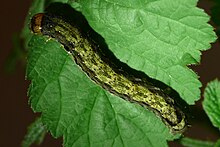Two-spot kitten owl
| Two-spot kitten owl | ||||||||||||
|---|---|---|---|---|---|---|---|---|---|---|---|---|

Two-spot kitten owl (male) |
||||||||||||
| Systematics | ||||||||||||
|
||||||||||||
| Scientific name | ||||||||||||
| Anorthoa munda | ||||||||||||
| ( Denis & Schiffermüller , 1775) |
The two- spot kitten owl ( Anorthoa munda , syn .: Orthosia munda ), also known as the brown-yellow spring owl, is a butterfly ( moth ) from the family of the owl butterflies (Noctuidae).
features
butterfly
With a wingspan of 37 to 45 millimeters, the moths belong to the medium-sized owl butterflies. The basic color of the forewings ranges from gray-yellow or brownish to reddish and includes all color variants in between. Ring and kidney defects are outlined in yellow. On the indistinct wavy line there are usually two inwardly directed black spots. Sometimes there are still spots on the inner corner. Specimens in which the stains are completely absent are classified as f. called immaculata . The hind wings shimmer gray-brown without drawing. The antennae of the males are serrated on both sides, those of the females are thread-shaped.
egg
The hemispherical egg is yellowish white in color and shows weak ribs, a reddish brown central spot and an equally colored narrow cross band. The micropyle region is somewhat preferred.
Caterpillar
The caterpillars are usually yellow-brown to green-brown in color and have dark brown droplets. However, there are also specimens that are broadly black on the sides and form a strong contrast to the light back and belly. White spots on the 4th and 5th segments are typical of the species.
Doll
The doll is identified by two downwardly curved tips on the cremaster .
Similar species
- From the sister species Anorthoa fabiani , which occurs in Taiwan , munda differs in its smaller size.
- Compared to Anorthoa angustipennis , which occurs in the temperate zones of the Pacific region, the munda shows a wider toothing of the male antennae, approximately square kidney defects and less pronounced ring defects.
A genital morphological examination is required for an unequivocal determination .
Geographical distribution and habitat
The occurrence of the species extends through most of the countries of Europe to East Asia including Japan . It is only missing in the very north and in the very south of Europe. In Taiwan , the isolated living ssp. plumbeata native. In the Alps it occurs up to a maximum height of 1200 meters. The two-spot kitten owl can be found in various habitats, for example in deciduous forests, on bushy forest edges as well as in gardens and parklands.
Way of life
The moths are crepuscular and nocturnal and visit numerous artificial light sources as well as bait , but prefer blooming pussy willow or tree sap for feeding . Their very early flight time runs largely parallel to the willow blossom ( Salix ) and therefore mainly covers the months from March to May. The caterpillars live from May to July. During the day they like to hide in the bark of tree trunks. They feed polyphagously on the leaves of various trees and shrubs, for example poplar ( Populus ), birch ( Betula ), willow ( Salix ) and oak species ( Quercus ) as well as blackthorn ( Prunus spinosa ), hazel ( Corylus ) or raspberry ( Rubus idaeus ). They are also found on low plants, e.g. B. to find orchids ( Orchis ). The species overwinters as a pupa.
Danger
The two-spot kitten owl is widespread in Germany and can be found in large numbers in some areas. Accordingly, it is classified as not endangered on the Red List of Endangered Species .
swell
Individual evidence
- ↑ a b c d Lázló Ronkay, José Luis Yela & Márton Hreblay: Hadeninae II . In: Michael Fibiger, Martin Honey (Ed.): Noctuidae Europaeae . tape 5 . Entomological Press, Sorø 2001, ISBN 87-89430-06-9 (English).
- ↑ Manfred Koch : We identify butterflies. Volume 3: Owls. 2nd, expanded edition. Neumann, Leipzig / Radebeul 1972, DNB 760072930 .
- ↑ a b c Walter Forster , Theodor A. Wohlfahrt : The butterflies of Central Europe. Volume 4: Owls. (Noctuidae). Franckh'sche Verlagshandlung, Stuttgart 1971, ISBN 3-440-03752-5 .
- ↑ a b Günter Ebert (Ed.): The butterflies of Baden-Württemberg . 1st edition. tape 7 . Moth V Noctuidae 3rd part. Ulmer, Stuttgart (Hohenheim) 1998, ISBN 3-8001-3500-0 .
- ↑ Federal Agency for Nature Conservation (Ed.): Red List of Endangered Animals in Germany . Landwirtschaftsverlag, Münster 1998, ISBN 3-89624-110-9 .
literature
- Günter Ebert (Ed.): The butterflies of Baden-Württemberg . 1st edition. tape 7 . Moth V Noctuidae 3rd part. Ulmer, Stuttgart (Hohenheim) 1998, ISBN 3-8001-3500-0 .
- Lázló Ronkay, José Luis Yela & Márton Hreblay: Hadeninae II . In: Michael Fibiger, Martin Honey (Ed.): Noctuidae Europaeae . tape 5 . Entomological Press, Sorø 2001, ISBN 87-89430-06-9 (English).
Web links
- Lepiforum eV photos
- www.schmetterlinge-deutschlands.de Endangerment
- Anorthoa munda in Fauna Europaea. Retrieved July 21, 2011

